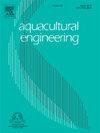用于可持续虾类养殖的CFD优化太阳能物联网集成桨轮曝气机-综述
IF 4.3
2区 农林科学
Q2 AGRICULTURAL ENGINEERING
引用次数: 0
摘要
本研究综述了旨在改善亚洲对虾集约化养殖中桨轮曝气机性能和能源效率的研究和开发工作。通过实验设计和操作参数优化,以及利用计算流体动力学(CFD)方法改进桨轮设计,回顾了以往提高氧传递效率的研究。该综述还涵盖了通过集成物联网(IoT)系统来实现基于虾池溶解氧(DO)水平实时控制的桨轮曝气器的自动化。此外,它还探讨了太阳能光伏(PV)系统的使用,以减少对电网电力和能源消耗的依赖。然而,需要进行综合研究,将基于cfd的桨轮曝气机设计、物联网技术集成和太阳能的使用结合起来,以提高亚洲半集约化和集约化虾养殖中商用桨轮曝气机的实时性能和能源效率。文献中尚未对这些系统通过物联网反馈实时适应不断变化的环境条件的能力进行实质性研究。这些技术的高潮为提高桨轮曝气机的效率、虾养殖操作的可持续性和盈利能力提供了巨大的可能性,同时降低了投入成本,最大限度地减少了对环境的影响。本文章由计算机程序翻译,如有差异,请以英文原文为准。
CFD optimised solar powered IoT integrated paddlewheel aerator for sustainable shrimp farming – A review
The present study reviews the research and development efforts aimed at improving paddlewheel aerator performance and energy efficiency in intensive shrimp farming in Asia. It examines previous studies to improve oxygen transfer efficiency through experimental design and operational parameters optimization, as well as the use of the computational fluid dynamic (CFD) method for paddlewheel design improvement. The review also covers the automation of the paddlewheel aerators by integrating Internet of Things (IoT) systems for real-time control based on dissolved oxygen (DO) levels in the shrimp ponds. Additionally, it explores the use of solar photovoltaic (PV) systems to reduce the reliance on grid electricity and energy consumption. However, there is a need for comprehensive research that combines CFD-based paddlewheel aerator design, IoT technology integration, and the use of solar power to improve the real-time performance and energy efficiency of commercially available paddlewheel aerators use for sustainability of semi-intensive and intensive shrimp farming in Asia. The evaluation of these system's ability to adapt in real-time to changing environmental conditions via IoT feedback has not been substantially studied in the literature. The culmination of these technologies offers a significant possibility to improve the efficiency of paddlewheel aerators, sustainability and profitability of shrimp farming operations while lowering the input costs and minimizing the environmental effects.
求助全文
通过发布文献求助,成功后即可免费获取论文全文。
去求助
来源期刊

Aquacultural Engineering
农林科学-农业工程
CiteScore
8.60
自引率
10.00%
发文量
63
审稿时长
>24 weeks
期刊介绍:
Aquacultural Engineering is concerned with the design and development of effective aquacultural systems for marine and freshwater facilities. The journal aims to apply the knowledge gained from basic research which potentially can be translated into commercial operations.
Problems of scale-up and application of research data involve many parameters, both physical and biological, making it difficult to anticipate the interaction between the unit processes and the cultured animals. Aquacultural Engineering aims to develop this bioengineering interface for aquaculture and welcomes contributions in the following areas:
– Engineering and design of aquaculture facilities
– Engineering-based research studies
– Construction experience and techniques
– In-service experience, commissioning, operation
– Materials selection and their uses
– Quantification of biological data and constraints
 求助内容:
求助内容: 应助结果提醒方式:
应助结果提醒方式:


